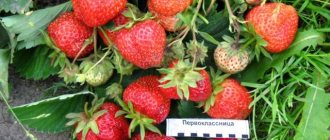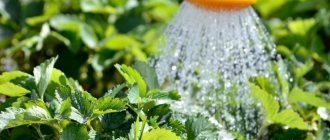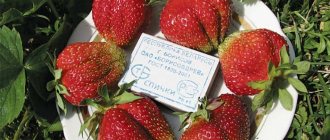History of the variety's creation
Strawberry Borovitskaya is a variety of Russian selection, it was bred by breeders from the All-Russian Selection and Technological Institute of Horticulture and Nursery Growing. When breeding it, such well-known varieties as Nadezhda and Redgauntlet were crossed. In 1992, Borovitskaya strawberries were grown in experimental plots and tested. And this strawberry variety was added to the State Register of Russia only in 2003.
Borovitskaya strawberries were recommended to be grown in the Volga-Vyatka and Far Eastern regions, including in the following areas:
- Kirovskaya;
- Sverdlovsk;
- Nizhny Novgorod;
- Sakhalinskaya;
- Magadan;
- Amurskaya;
- Kamchatskaya.
Strawberry Borovitskaya - photo
You can also grow this variety in the following areas:
- Perm;
- Primorsky;
- Khabarovsk.
INTERESTING!
The best strawberry varieties for Siberia
Care instructions
Garden strawberries "Borovitskaya" belong to the category of highly productive and need good care, guaranteeing a high and stable harvest. Therefore, when growing, the following recommendations should be followed:
- if there is a dry and fairly warm spring, then the first watering of strawberries should be done at the end of April;
- It is recommended to water the berry crop early in the morning so that the leaves have time to dry when water gets on them;
- Irrigation measures should be carried out throughout the entire growing season, which will allow plants to receive adequate nutrition at all stages of development;
- watering garden strawberries after harvesting is mandatory and contributes to the full formation of flower buds on the berry crop;
- a few weeks after planting, it is recommended to apply 5 kg of manure per square meter under well-rooted plants;
- during the period of active fruiting, it is recommended to feed strawberries with urea or a solution using ordinary wood ash;
- throughout the season, you can use special fertilizers for garden strawberries for fertilizing or apply organic fertilizers such as infusion of chicken manure or mullein to berry plantings;
- After the final harvest, the plants need to be fed with mineral fertilizers.
Throughout the growing season, the soil is regularly loosened, especially after watering, and all weeds are systematically removed.
Strawberry Borovitskaya: main characteristics and description of the variety
This strawberry variety is practically the latest among all varieties bred in Russia and abroad. In the Moscow region, the harvest from the Borovitskaya strawberry plantation is harvested only in the last days of July, and in the south of the country - a month earlier.
Strawberry bushes of this variety are of medium size, they are erect and medium spreading. A lot of foliage is produced, it is large in size, medium wrinkled, dark emerald in color.
A lot of mustaches form, so some of them have to be removed regularly
so that they do not take nutrients “on themselves” when fertilizing is so necessary for the ripening of berries.
Photo of Borovitskaya strawberry
Peduncles are thickened, long, with slight pubescence, growing above the leaves. Flowers on peduncles are formed of male and female types, so this variety does not require additional pollinators. The flowers are collected in inflorescences, each of which can form 5-6 ovaries. The flower stalks do not lie on the ground even under the weight of ripe berries, but experienced gardeners recommend placing supports under the flower stalks during the period of berry ripening.
The berries of this variety set well. Borovitskaya strawberry is considered large-fruited - the weight of the berries is 38-40 g
. The fruits have a regular cone shape with blunt tips and a wide base. The fruits have no neck.
The first ripening berries are the largest, but they often grow together and therefore can take on irregular shapes. Voids often appear inside the pulp of such fruits. And fruits weighing less than 35 g have a regular, beautiful shape and do not have voids inside.
Not fully ripened strawberries have a brick-red color; when fully ripe, the berries become cherry-red.
Garden strawberry (strawberry) Borovitskaya - video
The pulp is compacted, but with a lot of juice, its color is soft red. Borovitskaya strawberries have a pleasant taste - sweetish with slight sourness and a strong strawberry aroma.
The separation from the stalks is dry.
On a note!
But experts do not rate the taste qualities of the fruits of the Borovitskaya strawberry variety very highly - their tasting score is only 4 points out of 5 possible.
This late-ripening berry crop is classified as a dessert crop, so the collected fruits are used for fresh eating and for preparing various desserts, as well as jam and marmalade, marmalade, and frozen for the winter.
Borovitskaya strawberries are highly resistant to frost - they can withstand temperatures down to -34 degrees Celsius when covered only with a layer of snow.
Reviews
Borovitskaya is my favorite. It bears fruit when all other varieties have already finished bearing fruit. The yield is high, of the varieties that I grow at home, only Lord’s is higher. I also like the taste, I just need to wait until the berries completely darken. In rainy weather there is sourness and a less pronounced aroma, but this is observed in all varieties.
Gardeners are attracted to Borovitskaya by its aromatic and unique taste and resistance to low temperatures. It's nice to harvest large, beautiful cherry-colored fruits. If you need strawberries for personal consumption and not for sale, you should pay attention to this domestic variety, which is perfectly adapted to our climatic conditions.
Advantages of the variety
The main advantages of the Borovitskaya strawberry variety include:
- thanks to the late ripening of fruits, gardeners are able to extend the strawberry season almost until the end of July;
- flowers bloom late, when spring return frosts have already ended;
- a large number of ovaries are formed on the bushes;
- the berries ripen quite smoothly;
- bushes are able to tolerate heat, drought, high soil and air humidity;
- high frost resistance;
- with proper care, the yield of this variety is quite decent;
- the second wave of the harvest has excellent presentation and taste;
- the high resistance of this strawberry plantation to most diseases characteristic of other strawberry varieties.
Among the disadvantages of Borovitskaya strawberries, only the main ones should be noted:
- not too high yield, which is why this variety cannot be grown for further sale;
- fully ripened fruits are too soft and juicy, so they do not tolerate transportation even over short distances;
- at the stage of incomplete ripeness, the berries are not too sweet, so the taste of the fruit is far from truly dessert.
Important!
With increased soil moisture, this variety continues to bear fruit as usual, but the bushes may be affected by gray rot.
Treatment against diseases and pests
According to the description, Borovitskaya strawberries demonstrate resistance to diseases characteristic of the crop, but this factor does not eliminate the risk of infection.
Common diseases:
- Gray rot. This problem can be diagnosed by brown spots with a gray coating on the foliage and fruits. Treatment involves the removal and subsequent destruction of all damaged parts of the plant. To combat the fungus, spray the bushes with a solution of potassium permanganate or iodine.
- Powdery mildew. The disease manifests itself as a white coating on the leaves, which later acquires a bronze color. Severe infestations require plant treatment with fungicides.
Nematodes and strawberry mites are considered dangerous pests for the Borovitskaya strawberry variety. They mercilessly destroy plants, feed on roots, leaves, and some of them prefer to feast on fruits; in addition, they are carriers of dangerous diseases. Control such parasites by treating the bush with insecticidal and acaricidal preparations.
When using chemicals, you must follow the application rates prescribed in the instructions and the timing of the last treatment before harvesting.
Borovitskaya garden strawberry: rules for planting and propagation
To get good yields from the Borovitskaya strawberry variety, it is important not only to plant it correctly and then take good care of it - it is also important to choose good, healthy seedlings. Healthy seedlings should have a root collar with a diameter of at least 5-6 mm, 5 bright green leaves, a whole apical bud and healthy white roots about 4 cm long.
Rules for planting strawberries and wild strawberries - video
Before planting, it is recommended to keep the Borovitskaya strawberry seedlings in a cool place for two days, which increases the plant’s resistance to external adverse weather conditions in the future.
. Before planting, the roots are slightly trimmed and treated with any growth stimulant.
On a note!
You can plant Borovitskaya strawberries both in spring and autumn, but for better survival rate it is recommended to plant rosettes of this variety in the last ten days of August or early September.
The area for planting this variety of strawberries should be well lit by sunlight, protected from gusts of cold wind and strong drafts. The soil for planting should be well fertilized and loose; it is best to plant strawberries on black earth or loamy soils. Groundwater should not approach the earth's surface closer than 1.0 m.
Beds for planting Borovitskaya strawberries in open ground are prepared in advance: all plant residues are removed along with roots, at least 7-8 kg of organic matter is added to each square of area, and digging is carried out. The soil for spring planting is prepared in the fall. When planting strawberry seedlings at the end of summer or autumn, the beds should be prepared 25-30 days in advance. This is necessary so that the soil has time to settle before planting the plants, otherwise their root system may be exposed.
Borovitskaya strawberries are usually planted using the strip method.
, while the distance between adjacent plants in a row should be about 0.35 m, and between ribbons - about 0.7 m.
Water is poured into the prepared holes, after it is absorbed, seedlings are placed in the holes, the roots are straightened and the holes are sprinkled with soil. It is compacted, then the bushes are watered, then the ground around the bushes is mulched with organic matter.
Plants should be planted in cloudy weather
. If it is hot, then in the first week after planting it is better to shade the bushes so that they acclimatize normally.
Culture propagation
The Borovitskaya strawberry variety propagates easily and without financial costs. The culture produces many tendrils that tend to take root and create numerous rosettes. If the main goal of cultivation is reproduction, then it is recommended to remove flower stalks and sacrifice yield for abundant and rapid growth of the mustache.
In other cases, stolons must be removed, since their development can negatively affect both the number and size of berries.
Strawberry Borovitskaya: further care
When organizing the care of Borovitskaya strawberries, you need to pay close attention to compliance with the irrigation regime.
. Although this variety tolerates periods of drought and heat well, without abundant and regular watering the berries can become smaller, and voids can form in the pulp.
It is necessary to water as the soil dries out, especially often during the flowering period.
Water should be applied only at the root, avoiding drops of moisture on the foliage and flowers - this can provoke the development of gray rot.
Strawberries negatively perceive the appearance of weeds in the beds, so after each watering it is necessary to loosen the soil while simultaneously removing weeds.
Tips for caring for the variety
It's no secret that to get a good harvest, strawberries also need to be provided with high-quality care. In the case of the Borovitskaya variety, the following tips from experienced gardeners will be useful:
- Gardeners consider the most important point in the care process to be the right fertilizer. Like any other berry variety, Borovitskaya needs high-quality additional nutrition. In addition to the initial planting stage, reviews from gardeners advise feeding the plant at least three times during the season. At the same time, in early spring it is recommended to apply ammonia-type fertilizers, and during the establishment period it is necessary to reduce the amount of nitrogen compounds, focusing on the mineral type of fertilizing;
- Despite the fact that this variety of strawberries usually tolerates drought well, Borovitskaya also needs additional moisture. Watering the beds must be done regularly, especially monitoring soil moisture during the flowering period of the variety. In order to avoid putrefactive manifestations, reviews from gardeners recommend watering the berries at the root, avoiding water getting on the leaves;
- Despite the existing immunity, summer residents still additionally treat the berries against pests. The Borovitskaya variety can be processed either using a chemical composition or using the traditional method. For example, ordinary wood ash;
Additional nuances
There are also a number of tips from leading gardeners on plant care:
- You should especially carefully monitor the formation of weeds and remove them at the first warning signs. They help reduce the amount of moisture in the soil even with abundant watering, which can cause strawberries to dry out. To simplify the process of caring for berries, reviews from gardeners recommend resorting to additional mulching of the beds using one of the most popular methods;
- Some summer residents completely mow down the tops before the onset of cold weather. The Borovitskaya strawberry variety usually tolerates light frosts well. But in the case of a harvested berry, it is not worth completely depriving it of foliage, especially if the winter ahead is harsh. It will be enough to walk through the beds and clear them of diseased leaves and debris;
- The variety of this plant is usually not insulated for the winter. If the cold promises to be too severe, then you can insulate it with agrofibre or pine needles. Other types of mulch are also acceptable, but it is better not to use black film for this type of berry;
- Due to the presence of a large number of tendrils, propagating the strawberry variety is not difficult.
If the purpose of planting a berry is its further reproduction, then the peduncles must be removed. This step will lead to a decrease in yield, but will make it easy to create berry plantations. In other cases, the mustache must be completely cut off, because it is they that deprive the plant of its vitality. And this, in turn, negatively affects the quality of the crop.
Using these tips, you can not only learn how to properly care for strawberries, but also enjoy the delicious harvest of this dessert berry longer.
Fertilizing strawberry bushes Borovitskaya
Despite the fact that when planting Borovitskaya garden strawberries, all the necessary fertilizers were applied to the bushes, in the future during the summer season these berry plants need to be fertilized three times.
Feeding strawberry bushes
After the snow melts and the soil warms up to 13-15 degrees Celsius, ammonia fertilizers are applied under the strawberry bushes.
During flowering of a strawberry plantation, it is better to carry out foliar feeding. To do this, prepare a solution based on mineral fertilizers containing N, K, P, Ca. This treatment is repeated during the active formation of ovaries.
Watering and care
In hot and dry climates, Sybille strawberries need to be watered twice a week. But you need to look at the soil moisture; more or less watering may be required. Watering can be done in the usual ways, at the root or along the furrows, but the optimal method is drip irrigation.
Land that is not covered with mulch should be regularly cleared of weeds and weeded. The roots of Sibylla's strawberries are at the top, so loosening should be carried out no deeper than 3-4 centimeters. This will allow the root system to breathe and will improve the yield and growth of the bush
It is necessary to pay attention to the correct trimming of strawberry mustaches. Throughout the season, you need to trim your mustache, leaving 2-3 centimeters of growth.
If this is not done, the plant will devote all its energy to new shoots, which will affect the yield deterioration.
Borovitskaya strawberry: reviews from those who planted and grew the variety
Svetlana, 45 years old, Moscow region: I constantly look after Borovitskaya strawberries, so the yield of this variety may be higher than stated. One bed of these strawberries is enough to feed my whole family. Strawberry Borovitskaya is unpretentious in care, but loves regular feeding.
Natalya, 50 years old, Sverdlovsk region: Borovitskaya strawberries grow and bear fruit well in our region. For the winter, I still cover it with non-woven material, because winters in our region can be too frosty. But even if the bushes freeze a little, they quickly recover next season. I really like the appearance and taste of ripe Borovitskaya strawberries, but one thing is bad - they are practically not transportable. Therefore, I make all the strawberry preparations at the dacha, and only transport jars of strawberry jam to the city.
Borovitskaya strawberry is not suitable for growing on an industrial scale due to its not very high yield, but for growing in garden plots this variety is one of the best among the late-ripening varieties of this berry crop.
Recommendations for planting
Gardeners recommend planting Merlan strawberries no earlier than March-April. It is recommended to choose a southern or southeastern slope with a slight slope. It is advisable that there is no groundwater nearby, and that the berries are not exposed to direct sunlight. Merlan strawberries will bear fruit well on soil types such as black soil or clay varieties. Sandy or sandy loam cover will not be suitable, since Merlan will have nowhere to strengthen its roots, which are located near the soil surface.
More experienced summer residents, to save money and time, often use a mixture of chernozem and clay soil in certain proportions, which often gives better results. Merlan strawberries will grow well in soil with average acidity.
Also, when choosing a location, gardeners often take into account the predecessors that grew before planting the berries. The best plants that will saturate the soil with useful elements for Merlan strawberries will be:
- garlic and onion;
- various legume families;
- carrots and beets;
- green manure plants, for example, buttercups. They can also be used as a natural mulch for strawberry beds.
At the same time, summer residents do not advise planting berries after nightshades, as well as potatoes and cucumbers. Strawberries have a number of common diseases with these varieties of crops, which, if active, can ruin the entire crop.











